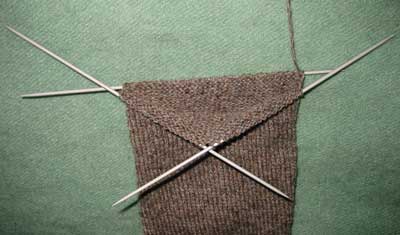
Must have been a bit groggy yesterday. This morning I thought, well duh, why not put a tape measure on the scanner bed so that people can accurately judge the size of the socks. So, here it is, metric and inches.
Some of you may be wondering why someone would knit socks by hand when you can buy them already made. This is the fifth day and I am not half done yet. One very important reason is that you can choose what kind of yarn to use. 100% wool is my usual choice. This is left from the past when I spent a lot of time outdoors, for recreation and work including tending fires and working with open flames.
In browsing the web, I have found patterns for hand knit socks dating from World War II, World War I, and the American Civil War. The patterns are pretty much the same as what I am doing now, so the design is proven. About the only difference from what knitters did then and what I am doing now is that I can choose needles made in a greater variety of materials. Typical admonitions are to use an undyed wool yarn and to weave in the ends instead of making knots when joining a new ball of yarn so that the inside is smooth. In the days before antibiotics, if a blister got infected, it could become a life threatening situation.
As I am using cone yarn, unless something unexpected happens, I will only need to weave in the starting end on the cuff and the ending yarn on the toe.
Wool socks feel warm and dry on your feet even if they get wet. If you are an experienced hiker or backpacker, you already know that you need to take care of your feet. A well broken in pair of sturdy hiking boots worn with good boot socks (one pair to wear and second pair as spares) can make the difference between the misery of blisters and bliss. I still carry a pair of wool socks in my bag or pack just in case the weather turns nasty when I go outdoors.
For full disclosure, I need to state here that my parents raised sheep for a few years beginning in 1978, and that I spun and knit yarn from them.
Shortly after I moved to Salt Lake City to work at the University of Utah, Geoff pulled over a pot of hot water and scalded his shoulder, suffering a second degree burn. He was treated at the University Medical Center, then referred to the regional burn center for follow up. While waiting for the appointment, Geoff played with three boys while I talked to their mother. The patient was wearing elastic burn bandages. His mother said that he had been caught in a house fire and that wearing cotton jeans saved his life as they protected his legs enough that there was skin available for grafting. He had been wearing a polyester shirt, which melted in the heat, clung to his skin, and actually made the burns worse. She had made it her mission to pass the word along to other parents to be careful about how they dressed their children.
When we went in, the doctor said that the burn had healed just fine but that we should have followed up with a family physician instead of visiting the burn center. Looking back, I think it was meant to happen.
So, I tossed the synthetic yarn in my stash. My son's wardrobe became cotton shorts and shirts in the summer and in the winter cotton jeans or cords, cotton shirts, and wool sweaters, socks, hats, and mittens. They take a bit more effort to launder, but that is a small price to pay for the safety of your child.
As you can see, yesterday I kept on knitting around so that the socks are about 9 inches total in length, consisting of a 3 inch cuff and 6 inches of stockinette for the lower calf and ankle. Now the main challenge is to see that the two socks are the same length when I stop for the heel. If they are slightly different, it will probably make no functional difference at all, will just look a bit odd when they are folded for storage. There are several ways to check the length:
Heels are another good reason to knit your own socks. I won't get into tube socks, but even if you find a manufactured sock with a knitted-in heel, it is just a bump on the side of a straight tube. If you stand on the floor and look at your foot, you will see that there is a 90° angle between your shin and the floor.
Once I am satisfied that the socks match, I take half the stitches (36) onto one needle and distribute the other half between two needles (18 stitches each). An easy way to do this is to take the sock that is folded as in the photo, move the 12 stitches you just knit onto the last needle, then shift six stitches to the next needle from the third needle.
It has been raining off and on all day, and following the heavy rain and storms of the last few days, SE Wisconsin is having flooding. Although I prefer using natural lighting, it is just too gloomy so I will use the flash.

This is a good time to take a break if you need one. We are about to do something that we haven't done so far and won't do again for these socks -- knit across and purl back to make a generous heel flap. More tomorrow.